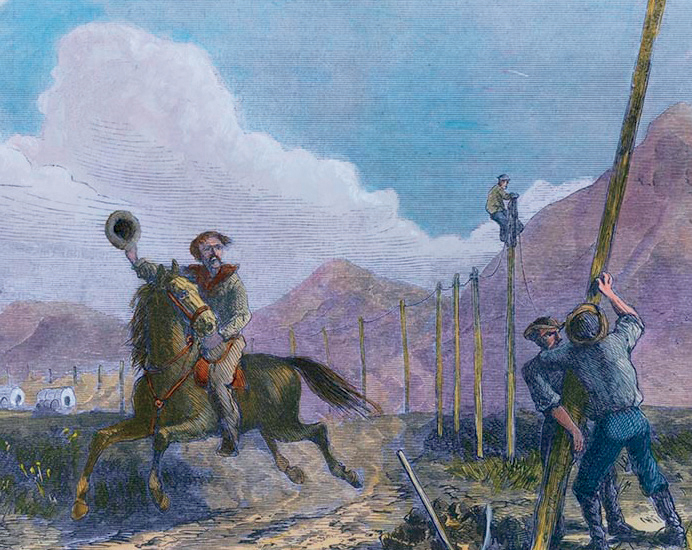Mr. Watson, come here. I want to see you. Scottish-born scientist Alexander Graham Bell said these words to his assistant, Thomas Watson, on March 10, 1876, in Boston, Massachusetts. Bell and Watson were in different rooms at the time. Bell wanted Watson to help him because he had spilled something on his clothes.
Watson ran to Bell to tell him the good news. Watson had heard Bells voice through their new machine. Bells words were the first ever heard through a telephone.
That same day Bell wrote a letter to his father telling him that the telephone was a great success. He said people would one day be able to talk to each other directly without leaving their homes or sending letters.
Alexander Graham Bells first demonstration of the telephone took place in Boston. in May 1876.
Before the telephone, most people talked to each other in person. They walked, rode horses, or traveled in stagecoaches to visit their friends and family.
People wrote letters to those who lived far away. But mail traveled slowly in the 1800s. A letter could take weeks or months to arrive. Letters also cost a lot of money to send.
THE PONY EXPRESS
From April 1860 to October 1861, the Pony Express delivered mail and news to the western United States. Riders carried the mail on horseback along the 1,900-mile (3,058-kilometer) route. They changed to fresh horses at stations along the way. It took about 10 days to deliver mail along the route.
A Pony Express rider goes by a man working on the transcontinental telegraph line, which would later put the Pony Express out of business.
MAIL BY RAIL
In the United Kingdom (UK), the first mail coach began traveling between London and Bristol, England, in 1784. By 1830, a mail train was making deliveries from Liverpool to Manchester.
This British stamp shows one of the first mail coaches in England.
In the United States, the first train to regularly carry mail traveled on the Baltimore and Ohio Railroad in 1832. By 1838 all U.S. railroads carried mail. Mail clerks sorted letters on the trains as they traveled across the country.
THE TELEGRAPH
In 1842 American inventor Samuel Morse finished a machine hed been working on for several years. It was a message-sending device that he called the telegraph. But it would be two years before Morse would find out if his new invention worked. He had to wait until he got the money to build a 38-mile- (61-km-) long telegraph line between Baltimore and Washington, D.C. Once he was able to test the machine, he sent the first telegraph message on May 24, 1844.
Samuel Morse
Telegraph messages were sent using a system of dots and dashes called Morse code. The messages were tapped out in Morse code on the machine. Then the machine sent the message through wires to another machine that tapped the coded message onto paper.
Telegraphs helped people communicate over long distances, but they had some problems. For one thing, people didnt have telegraphs in their homes. They had to go to telegraph offices. Plus, most people didnt know Morse code. Telegraph operators had to send and decode the messages, which left no room for sending private messages.
Telegraphs could also send only one message at a time, and sometimes they didnt work over very long distances. People needed a better way to communicate with friends and family.
MORSE CODE
Try sending your own messages in Morse code by tapping on a table using the list below. The dots are quick taps, the dashes are longer taps.
3
INVENTORS
Technically, the telephone was not invented by just one person. Scientists in Great Britain, France, Germany, and the United States all contributed ideas that led to the first telephone.
MICHAEL FARADAY
In 1831 British scientist Michael Faraday was able to make electricity with a wire and a magnet. He also built the first electric motor in the early 1820s.
British scientist Michael Faraday
Before Faraday, many people believed that electricity was a liquid. But Faradays experiments proved that electricity was a force. It traveled like a wave along different materials at different speeds.
Later, many inventors used Faradays work with electricity to create their own inventions. People used his ideas about electricity to develop many machines, including the telephone.
Faraday passed electricity through these metal coils. This made the coils magnetic.
CHARLES BOURSEUL
In 1854, French scientist electricity.
Charles Borseuls ideas about sound paved the way for the invention of the telephone.
JOHANN PHILIPP REIS
Between 1860 and 1862, German teacher and inventor Johann Philipp Reis worked on a machine he built that changed sound into electricity. It then sent the electricity as vibrations through a wire. The electricity was changed back into sound at the other end of the wire. Reis called his machine a telephone. But his invention could send only faint sounds, and it was difficult to make out what the voice at the other end was saying.
Johann Philipp Reis telephone system was the first of its type.
DID YOU KNOW?
Reis machine was built out of several strange parts, including a carved wooden ear, a knitting needle, and a violin. The caller spoke into the wooden ear. Inside the ear, metal parts vibrated, sending vibrations down copper wires that ran into another room. The wire ends were wrapped around a knitting needle that was placed inside the violin. The receiver put his or her ear next to the violin to listen to the vibrations.

























